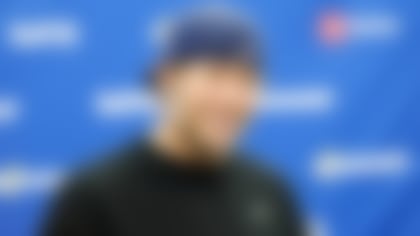ASHBURN, Va. -- Mike Shanahan and Robert Griffin III have both said, repeatedly, that any problems lingering from decisions made on the first weekend in January on the shredded turf of FedEx Field have since subsided.
Some people buy it. Others do not. But don't get this part twisted -- the Washington Redskins are every bit as smitten with the young quarterback now as they were when they dealt away a vault of draft picks to get him, and when he helped them run off seven straight wins en route to a playoff berth late last fall.
Just ask Shanahan.
Instant Debate: RG3 rehabilitation
Is **Robert Griffin III** trying to move too quickly in his rehabilitation from knee surgery? Our analysts debate the topic. **More ...**
"If Robert plays like he did (in 2012) the rest of his career," Shanahan said Thursday, a couple of hours after an organized team activity concluded, "he'll go down as one of the best quarterbacks to ever play the game."
Even with a bulky, hinged brace wrapped around Griffin's now-twice-surgically-reconstructed right knee -- and Griffin without so much as a practice jersey on -- it was clear Thursday that his star has never shone brighter in D.C. The 90-minute workout, which included Griffin throwing with a group of rehabbing players (including Pierre Garcon, Roy Helu and Fred Davis) for about 20 minutes, was covered like a playoff game. That will be true of the rest of the Redskins' practices until Griffin is back under center.
No one dared offer a firm timetable as to when Griffin would eat dinner Thursday night, much less when he'd return to the field. But there was no mistaking the unspoken confidence here from a) Griffin (that'll he hit all his target dates), and b) everyone else (that the quarterback will do everything possible to be back on the practice field at training camp and on the game field for Week 1).
The question becomes what happens between now and then, as the Redskins try to move the program forward after winning their first NFC East title in 13 years.
Shanahan doesn't think much has to change. Asked if the offense can seamlessly transition from the more stationary Kirk Cousins to Griffin, and keep growing with Cousins taking practice reps now for an offense Griffin will eventually command, the coach responded, "You better be able to, if you're gonna last in this league." And he offered up Washington's December game in Cleveland, which Cousins started and won in a pinch, as Exhibit A regarding the adaptability of the offense.
"We have the ability with our offense to do anything," he said. "We can run our offense for whatever the talents of the quarterback are. So whatever we feel is the best offense for Kirk, we're gonna run it, like we did against Cleveland. Whatever we think gives Robert the best chance to be successful, we'll do that for Robert. Every year, a quarterback grows, and we're gonna do what we think is best to utilize the talents of those guys."
With that in mind -- and with the knowledge that the Redskins plan to be conscientious in bringing Griffin back to the game field -- the focus of this particular talk with Shanahan, held under an empty practice bubble that had been filled with media 30 minutes earlier, pushed forward to the 2013 season. In this case, that meant peering past all the important work ahead -- but also looking back, to find lessons through the process.
'There's a fine line'
It's hard not to start with the heat-of-the-moment calls made by the Redskins, Shanahan and Griffin himself in their wild-card matchup against the Seattle Seahawks on that soggy January afternoon. Griffin stayed in the game. A lateral collateral ligament injury became compounded by an anterior cruciate ligament injury. And yet, Shanahan doesn't harbor regret.
"I've been doing the same thing for 20 years as a head coach," Shanahan said. "What you do is, you talk to the doctors, and you get what they say and see if there's something wrong with the knee, or you talk to the player. Then, after you talk to the doctor and the player -- and you're not back there talking to the guy the whole time -- but after you do talk to the doctors and they give you a thumbs up, and you talk to the player, you go."
More or less, Shanahan is recounting just how things went down in that particular circumstance.
But just because he's not going back and lamenting what happened doesn't mean there aren't lessons to be learned. In fact, one of the big steps Shanahan wants to see Griffin take now is the same one he's seen other athletic quarterbacks take.
It's not about turning RG3 into Peyton Manning or Tom Brady. Griffin is going to be who he is, which is what makes him so difficult to defend. It's more about knowing the landscape and being able to intuitively assess when there's more to be lost than gained.
"It's a challenge for any guy who has an ability to make plays running," Shanahan said. "And when you get guys that are very competitive, you understand, guys are gonna try to make plays, but there's a fine line there in doing what's in the best interest of your football team in trying to win a football game. I think that's what everybody does as they grow as football players."
Both Shanahan and Griffin said Thursday it's impossible to know how much they'll change the offense in 2013, because they don't know what defenses will throw at them.
It's actually a pretty fair train of thought, despite the hue and cry over play-calling. Each of Griffin's injuries last season -- from the concussion earlier to the initial knee injury later -- came on scramble plays. So where some argue that the Redskins need to scale back on designed quarterback runs and option plays, Shanahan goes the other way, reasoning that those concepts actually protect the quarterback.
"Just take a look at the pass rush. A lot of times, it'll neutralize the pass rush, and your quarterback will have a lot of time to throw a play-action pass," Shanahan explained. "Defensive coaches can stop everything. If you wanna stop the zone-read, you can stop the zone-read, but what are you giving up to stop the zone-read? Is it the play-action pass? Is it your normal offense? You can stop everything. These defensive coaches are very smart. But what do they give up in return?"
His point is that the Redskins simply are trying to threaten defenses in as many ways as are possible with Griffin. Does he have to protect himself better? Sure. Does that mean abandoning the option? No.
'You still gotta stop it'
This is the time of year that NFL teams use to evolve, and if you go off of the small sample size that Thursday's practice provided, this offseason will be more about evolution for the Redskins than the revolution they went through last year.
Cousins ran option plays and designed runs, with the thought that he might be able to siphon off 12- or 15-yard gains against overcommitting defenses, where Griffin might go for 60. It was also for the benefit of the rest of the Redskins, who will have to run those plays with Griffin.
One thing's for sure -- the narrative that NFL coaches are going to catch up to the option game, which has been successful in college forever, isn't one that Shanahan believes in.
"Could you go in the National Football League and only run the zone-read? No," Shanahan said. "But we don't run the zone-read that much. We ran it four times against Philly, we ran it two times in another game, we ran zero times in another. People don't realize how many times you've run it. We ran it against Dallas 10 times. Our running back (Alfred Morris) had over 200 yards rushing. It all depends on what they're doing defensively; that'll determine if we run it."
Maybe the larger question here is to ask why the Redskins would even consider changing much. They averaged 6.2 yards per offensive play last season, which ranked first in the NFL. They averaged 8.3 yards per pass attempt in 2012, also first in the NFL. They averaged 5.2 yards per rush last year, which -- you got it -- led the league.
Shanahan then added, with a smirk, "There are a lot of different ways to defend it. We'll just wait and see what people do next year. But believe me, I know how to defend the zone-read option. You still gotta stop it. It all depends how good those players are."
"If Robert plays like he did (in 2012) the rest of his career, he'll go down as one of the best quarterbacks to ever play the game."
We know the Redskins have a good one under center. The idea now is to keep moving things along enough, so that Washington remains a step ahead.
Griffin is just part of that -- albeit a big part -- in Shanahan's view. He wants the quarterback to improve like everyone else, but he's already seen that capability, most notably last year, when a bottom-of-the-league third-down offense became one of football's best by the end of the season.
The way the coach sees it, Griffin and the offense around him just need to keep ascending. Shanahan already glimpses the potential for the 23-year-old to become an all-time great. So as Griffin works his way back, with two significant rehab steps left before he can practice again, Shanahan is anxious to keep the ball rolling.
"That's why you give up two 1s and a No. 2 for him. You give those things up because you see something very, very special," he said. "You see what type of athlete he is and what type of ability he has. He can make every throw on the field, he's extremely bright, he's got great work ethic, and he's got passion for the game. Those are the things you look for. Now, the rest is taking it to the field."
And everyone -- from outside observers to the insiders here in Washington -- is waiting for Griffin to do just that.
Follow Albert Breer on Twitter @AlbertBreer



